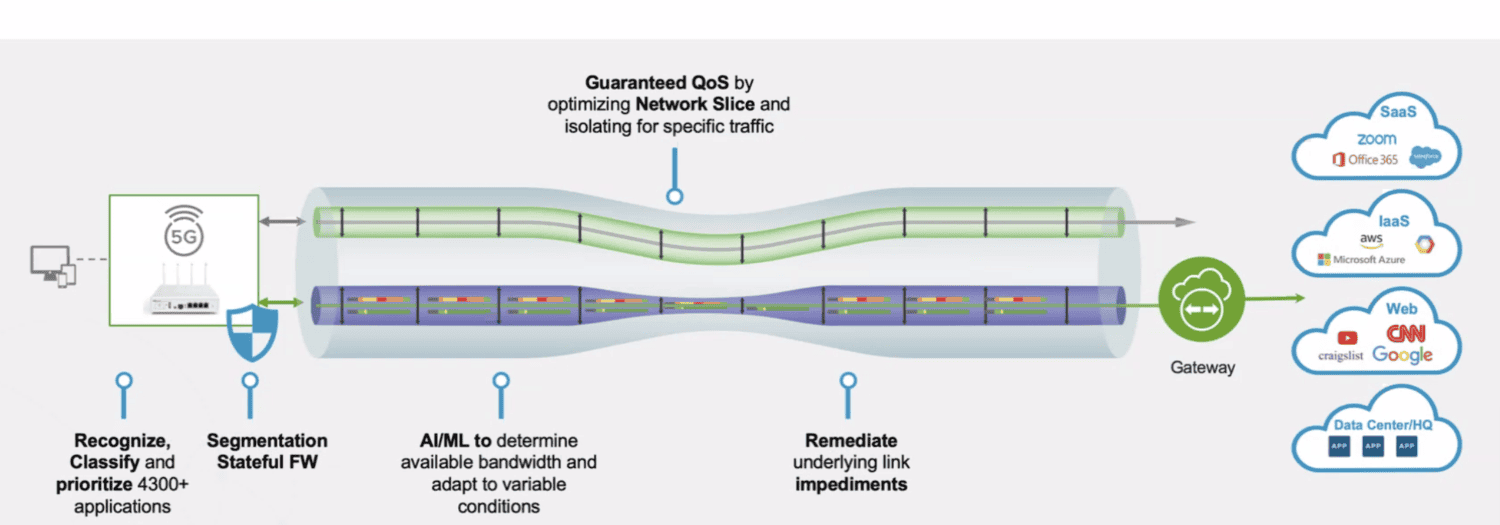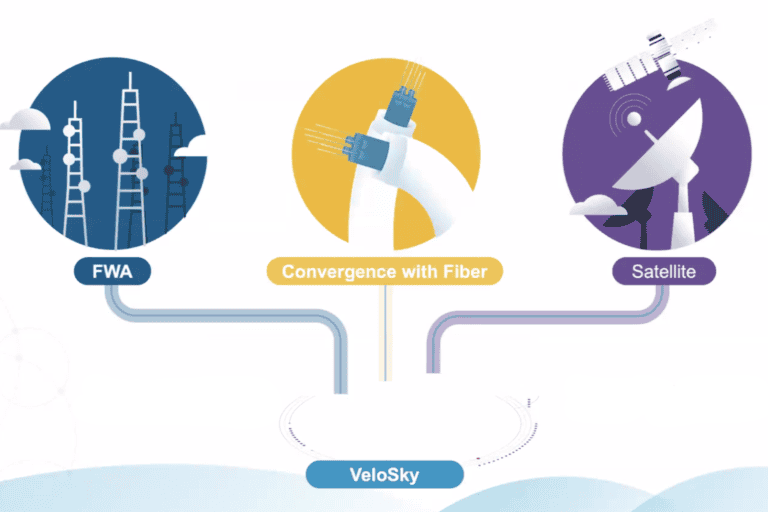With VeloSky, Broadcom promises service providers that they no longer need to deploy multiple appliances side by side to provide Fixed Wireless Access (FWA), fiber and satellite connections. A single VeloSky appliance will suffice. You can read how this is possible in this article.
During VMware Explore last November, we wrote about a new architecture for VeloCloud, Broadcom’s SD-WAN offering. VeloRAIN (Robust AI Networking), as the name suggests, focuses primarily on the new challenges of AI workloads for service provider networks. They obviously want to provide an optimal user experience to their customers, no matter which way they connect. Through Broadcom VeloRAIN, that should become possible.
What is Broadcom VeloRAIN again?
To refresh your memory, below we repeat what we wrote about Broadcom VeloRAIN last November, based on a briefing we attended then from Sanjay Uppal, the SVP and GM of Broadcom’s VeloCloud division.
For Broadcom, VeloRAIN is the foundation for all the networking innovation the company is doing in the field of AI. It should boost the entire portfolio. At least that’s what Sanjay Uppal, the VP and GM for the VeloCloud division at Broadcom, says. By this he means not only distributed inferencing workloads, but also agentic applications and heavy Retrieval-Augmented Generation (RAG) tasks. It is intended to improve not only the user experience in such workloads, but also security.
Broadcom VeloRAIN (the company no longer seems to use the prefix VMware in conjunction with VeloCloud) consists of several components. First, VeloRAIN uses AI and ML to detect AI applications. This was not possible or difficult to do until now due to the fact that this traffic was encrypted, among other things. That made it difficult to effectively identify AI applications and then also be able to provide them with appropriate prioritization on the network. Without that prioritization, it is hard to to guarantee performance. In other words, the Quality of Service was not as it should be.
The second part of VeloRAIN is concerned with optimizing the use of the network. It brings new features for intelligently estimating how to deploy and utilize channels of wireless links such as 5G and satellite. The goal is to be able to provide “fiber-like” Quality of Service over these wireless links. Not only that, these new features should also allow organizations to more easily and quickly set up and deploy a network at (edge) locations where they want it.
Finally, there’s the third component of VeloRAIN. This is not so much concerned with the network, but with setting up policies for prioritizing applications. For this, Broadcom uses AI, which should prioritize new applications automatically. It should also ensure that critical applications get the attention they deserve without the need for manual intervention. It also involves so-called DABS, or Dynamic Application-Based Slicing. This makes it possible to give applications an optimal Quality of Experience, regardless of the complexity of the underlying network. So that can include multiple networks.
Broadcom VeloSky: translation of the VeloRAIN architecture into an appliance
Now Broadcom VeloRAIN is back in focus, we can move on to the announcement Broadcom is making today at Mobile World Congress, which is VeloSky.
If we wanted to do a quick and dirty job here, we could say Broadcom VeloSky is the realization of everything we wrote about VeloRAIN above. VeloSky is an appliance with a software-defined layer on top that provides network access from this single environment via multiple routes: FWA, fiber, satellite. Broadcom calls this converged access. Service providers no longer have to roll out three different products to offer these three connection methods to customers.
However, the appliance itself is primarily a vehicle for what Broadcom actually envisions with VeloSky, we hear from Uppal. “DABS is what makes VeloSky special,” he points out. The idea is that thanks to this variant of slicing, where the application takes center stage, better Quality of Service can be offered, spread across different links.
Below is an illustration of how DABS works:

Just to be clear, Broadcom VeloSky is not an SD-WAN. It can exist in conjunction with Broadcom’s VeloCloud offering, with SD-WAN from another provider, or without SD-WAN.
Not DABS vs. network slicing, but DABS and network slicing
This application-based version of slicing is different from the network slicing we have known for some time. It can coexist just fine, by the way, but it is also available when network slicing is not. This is not a competition between DABS and network slicing, Uppal emphasizes. In fact, Broadcom is currently looking at a way to have the software and appliance dynamically determine whether to deploy DABS or network slicing.
The main result of this focus on the application is that it performs better and results in a better user experience for the customer. This has not been an easy feat at all, by the way, as Uppal tells us. The underlays of (wireless) networks tend to be very variable. Consider things like latency and jitter, among others. Exactly how variable these underlays are is difficult to estimate. Broadcom needs to estimate this without poking around too actively. It deploys AI to accomplish this.
Broadcom VeloSky offers convergence for service providers
With VeloSky, Broadcom wants to help service providers in particular in the tough FWA market. Among other things, the advent of satellite links is creating uncertainty for them. By offering multiple network underlays in a single appliance, service providers basically no longer have to worry about that. It also immediately makes rolling out new connections to customers a lot easier. That, in turn, means that service providers can bring in revenue faster. After all, it takes them much less time to roll it out.
Finally, the integrated approach almost naturally ensures better security. After all, there is only one appliance to consider. It’s not just about physically securing the VeloSky appliance. There is a firewall on the appliance, and Broadcom has applied the necessary segmentation. According to Uppal, they are looking at making this even more secure. They are now working on protecting data that goes upstream, a common situation with Retrieval-Augmented Generation in AI workloads. That data should not leak.
All in all, Broadcom VeloSky delivers on the promise the company made with VeloRAIN. VeloSky certainly is not finished by any means. The software-defined layer on top of the appliance makes VeloSky a flexible solution. It will certainly need to be, as connection requirements from service provider customers will undoubtedly be just as flexible moving forward.
